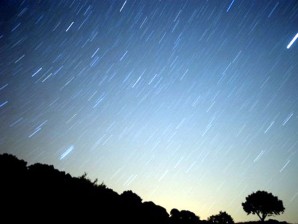
A meteor streaks across the sky against a field of stars during a meteorite shower early August 13, 2010, near Grazalema, southern Spain. This scenario is expected in the Philippines in the evenings of Dec. 13 and 14, 2012, when, according to the Philippine Atmospheric, Geophysical and Astronomical Services Administration, showers of meteors will occur. AFP PHOTO/JORGE GUERRERO
MANILA, Philippines—Gaze at the sky on Thursday and Friday nights and make a wish when “falling stars” appear during the annual Geminids meteor shower that will peak on these days, state meteorologists said.
The shower of meteors will be most visible in the evenings of Dec. 13 and 14, the Philippine Atmospheric, Geophysical and Astronomical Services Administration said in its “astronomical diary” for December.
“Under a dark and cloudless sky just after midnight of its peak activity, meteors or ‘falling stars’ can be seen at an average rate of forty meteors per hour,” Pagasa Administrator Nathaniel Servando said.
He said the shower “will appear to radiate from the constellation of Gemini, or the Twin.”
Other December evenings will also leave many stargazers spellbound by astronomical spectacles, Servando said.
The famous equilateral triangle, known as the Winter Triangle, rises after sunset, he said.
The Triangle is composed of Betelgeuse, the super giant red star and the prominent star of the famous constellation Orion (the Mighty Hunter); Sirius, the brightest star in the sky of the constellation Canis Major (the Big Dog); and Procyon, the brightest star of the constellation Canis Minor (the Little Dog).
On Dec. 21, the sun will reach the Winter Solstice at 7:12 p.m., Servando said.
“This marks the time when the sun lies at its farthest point south of the equator. It signals the onset of winter in the northern hemisphere and summer in the southern hemisphere,” he said.
This means Philippine nights will be longer than daytime, as the Earth has now completed another annual circuit around the sun.
From the beginning of December until its last week, Saturn, Venus and Mercury will have lined up in the east southeastern sky, as Venus and Mercury continue to slide down the horizon as days pass.
“It will be a spectacular view with the naked eye and will be a best time for photography, telescoping and binocular viewing,” Servando said.
Mars will remain visible a little higher than 12 degrees above the west southwestern horizon, an hour after sunset throughout the month.
It will be traversing the background stars of the constellation Sagittarius, or the Archer, for the rest of the month.
Meanwhile, an hour after sunset during the month, Uranus and Neptune will be visible among the background stars of the constellation Pisces, or the Fish, and constellation Aquarius, or the Water Bearer, respectively.
A binocular or a telescope and a star map will be needed to observe these gaseous planets. Both planets will be observable in the evening sky throughout the month.
Jupiter will rise around sunset above the eastern horizon. It can easily be distinguished due to its brilliance, lying at the back of the constellation Taurus, or the Bull, Servando said.
On Christmas Day and on the 26th Jupiter “will be pairing spectacularly with the Moon,” he said.